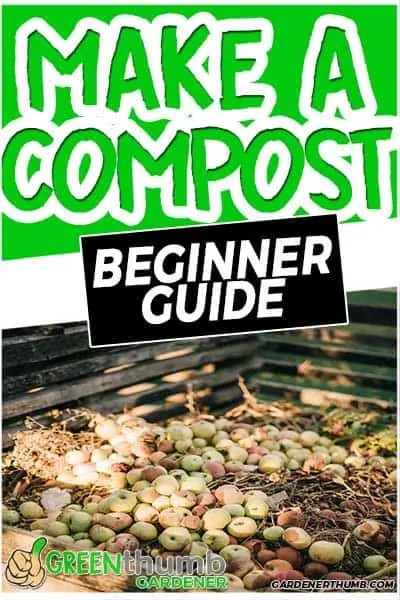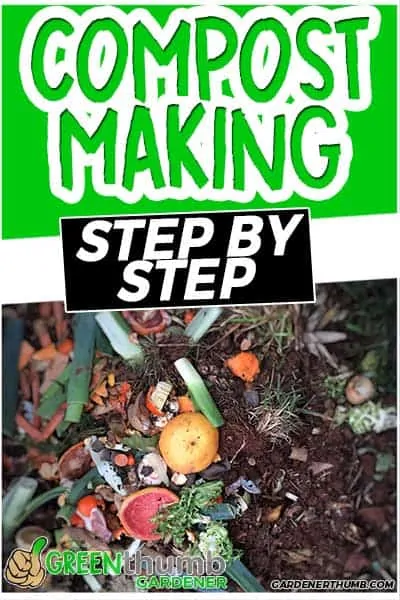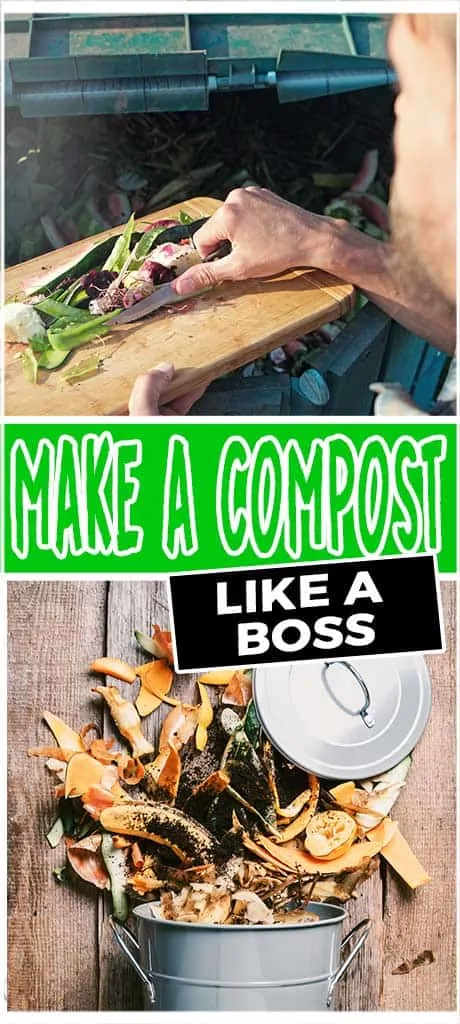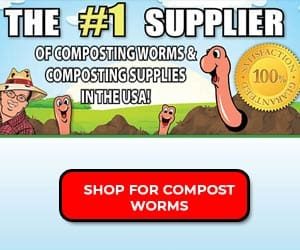Beginner Guide to Make Compost
Last updated: 12/17/20
Black Gold is what they call it. If you are doing some sort of gardening, you can agree with me on the importance of compost. But are you well acquainted with how to make compost step by step?
With a small garden in my yard, I had always found a way of disposing of my kitchen refuse and leftovers.
However, they were always messy and produced a foul smell. I knew of the health issues that could arise if I never found a way of addressing the issue.
Dig in to learn how to make compost step by step, from my personal experience and deep research on the topic.
Green thumb Gardener occasionally links to product and/or services offered by vendors to assist you with all your gardening needs. Some of these may be affiliate links, meaning we earn a small commission if items are purchased.
Want to Download a Garden Hack Guide for FREE

Enter your email below and we will send you a guide to help you SAVE money in your garden.
What is Composting?
Generally, composting involves decomposing organic matter in the presence of air to come up with natural fertilizer which is also known as compost.
Since it works with waste, you can make good use of your kitchen refuse. That heap that always worries you and how to dispose of it can now be recycled to make it useful.
How can composting affect the environment?
Composting basically transforms what otherwise was used as trash into black gold.
Kitchen refuse and leftovers when left in the open, they emit methane, a gas that can promote climate change. Composting greatly controls these emissions.
Besides, the use of compost manure eliminates the need for chemical fertilizers. Additionally, EPA has come out with study findings that show the capability of compost manure to capture up to 99 percent of volatile organic compounds (VOC) from the air.

Additionally, compost is crucial to farmers and gardeners. It is mostly used before or when planting new seedlings, because of its high water retention ability. This means you will spend less in watering your seedlings.
Likewise, compost is great in flower gardening and the whole process of crop production. It keeps the soil rich as it minimizes irrigation at the same time.
Can Composting go wrong?
Absolutely! If you do it wrong, you might end up with messy and smelly compost. Sometimes, the compost wetness or dryness can exceed. It can also get too old if left for long.
You can fix excess dryness by adding a little water. You can also remedy wetness by adding and mixing dry organic matter to absorb the excess liquid.
You do not have to worry about too old compost. Just add the old compost into fresh compost and watch it as you get rich manure.
3 Types of Composting
There are three common types of composting you can use. You can choose to use any of these types of composting.
It all depends on your circumstances, such as the time that you want your compost ready and the availability of the composting ingredients.
1.| Hot Composting
This is the quickest way of making organic manure for your garden. It involves preparing a big pile of organic materials. You have to gather all the ingredients that you need before kick-starting the process at once.
Usually, the temperature in this compost goes up to 160 degrees Fahrenheit with an average temperature ranging between 110 degrees Fahrenheit to 140 degrees Fahrenheit.
This temperature is too high for the survival of microorganisms causing disease and weed seeds.
In hot composting, you do not need to turn the materials to get the heat to be evenly distributed. With the right procedure, you will have your compost manure in just three weeks.
Consider piling your materials in the right size, and properly arranging your ingredients in the layers for a successful hot composting.
2.| Cold Composting
Unlike hot composting, cold composting takes a longer period to decompose. This may seem practical for the gardeners who have to gather their materials daily as it does not require all the ingredients all at once as the hot composting.
Cold composting can take up to 18 months before it gets ready to be used as manure. Since it decomposes at a low temperature, weed seeds don’t die. You are required to weed before allowing them to produce seeds.
3.| Worm Composting
Worm composting is another type of composting where worms, oxygen, and moisture are used to break down organic material safely.
Most people who prefer this type of composting are drawn by the process that yields almost odorless manure. In other words, the manure normally smells earthy.
Just like hot compost, this compost doesn’t require to be turned frequently. You can take a few minutes a week in maintaining the compost.
If you also engage in fishing, this compost will provide plenty of fish bait for you
Step By Step Compost Guide
Step 1: Choose Your Compost Bin to Use
You can choose to use an open pile or go for a compost bin. I have always used compost bins because of their ability to preserve more heat.
Compost bins also keep your space neat and orderly. You might find this type of compost the best if you live in an apartment or a shared dwelling with a limited area.
Another crucial aspect is deciding on whether to buy a compost bin or build your own at home. Whatever the case, consider the size of the bin you will acquire.

Too small will limit the amount of compostable material you will generate.
On the other hand, a too big bin may hinder the decomposition of the materials as it may lower the heat required to decompose the whole pile.
Step 2: Choose Your Location
The location of your pile is important for convenience purposes. Choose a location you can be able to access as you maintain your compost.
Besides, go for a flat, well-drained and sunny location.
Step 3: Prepare Your Site
If you choose to build a compost bin, get all the materials required, and prepare one. You can choose to prepare 3 feet deep compost. Then gather all the ingredients necessary.
Ensure you find the required green materials such as grass clippings, nettle leaves, vegetable peelings, and fruit peelings. The brown materials that you can also gather include hay and straw, woody pruning, tea bags, paper, cardboard, sawdust.
Remember when it comes to hot composting, you need to pile once. This means you need to gather every material for composting at this stage.
Step 4: Pile Up Your Bin
To take the temperature to the required levels, consider piling your materials closely. However, use loose and lightweight items to create air pockets that help prevent compaction.
From the bottom add bulkier materials like fresh plants and heavy woods. Mix three parts of brown materials with one part green counterpart. The green, fresh plants are essential for adding nitrogen.
If you realize too much wetness and smell from the pile, add more carbon-rich waste. If the carbon-rich waste becomes too much, add green materials. Ensure to balance the compost items well to keep it slightly moist.
Step 5: Water the Pile
Immediately after you have completed piling up your compost, spray water over it. This should not be done once but regularly. However, be careful when watering to avoid water logging your pile which might drown vital microorganisms that help in the decomposition process.
Step 6: Maintain Optimal Pile Temperature
The microbes in your pile play a great role in keeping it warm as they chew the materials. Use a thermometer to measure the pile’s temperature to ensure that the materials are decomposing well.
Alternatively, you can reach into the middle of the pile with your hand if you dare. This will help you be certain that it is warm enough to encourage compost rotting.
The internal temperature should lie between 105 and 145 degrees Fahrenheit.
Just like you will check on your pile to maintain moisture at optimum levels, the temperature should be maintained at this level.
If the temperature gets beyond 150 degrees Fahrenheit, aerate it. If it gets down below 100 degrees Fahrenheit, get a packaged compost starter and sprinkle over the pile to increase microbes.
Step 7: Turn Your Pile
Oxygen is useful for the organisms that actively engage in decomposition. To ensure that it is in plenty, use a garden fork or a shovel to stir up the pile once a week. You can also get a compost turner which is more convenient if you have a longer bin.
It is recommended to turn your pile when the temperature at the center of the pile lies between 105 and 145 degrees Fahrenheit. You can feel the warmth by reaching your hand if you lack a thermometer.
Stirring the pile thoroughly will speed up the rotting process, preventing the items in the pile from becoming matted down. Don’t worry about mixing up the layers at this stage as they will have served their purpose of equally spreading green and brown ingredients all over your pile.
This process also minimizes the chances of your pile producing an odor.
If you wonder where the odor comes from; it is caused by lack of enough oxygen which makes the microbes produce hydrogen sulfide, a foul-smelling compound.
Step 8: Harvest Your Compost
You know your compost is ready to be used in the garden when it becomes dark, dry with an earth-like smell, and ceases from giving off heat. Remove all compost manure; that is the fully decomposed matter and leave behind those not yet decomposed. Transferring unfinished matter to your garden may go along with microbes which will use nitrogen available in the soil and affect plant growth negatively.

Further Reading
What Can and Cannot Be Composted?
Are you curious about every common material recommended for composting and the ones to avoid? Here is a list of materials you can use and later the ones you should avoid completely.
What Can Be Composted
There are two main categories of materials to add to your compost. They include the following;
Nitrogen-rich waste
This includes most green materials such as:
- Grass clippings
- Nettle leaves
- Vegetable peelings
- Fruit peelings
- Annual weeds
- Nettle peelings
- Coffee groundnuts
- Young live fence trimmings
Carbon-rich Waste
This includes brown materials such as;
- Hay and straw
- Woody pruning
- Tea bags
- Paper
- cardboard
- Sawdust
- Leaves
- Pet bedding
What Cannot Be Composted
There are those materials that you should avoid. These materials may negatively affect the health of your compost.
For example, dairy products exclude oxygen that essential organisms need slowing down the process of composting. These materials include the following.
- Perennial weeds
- Raw meat or bones
- Dairy products
- Poultry and fish
- Whole eggs
- Cooked foods
- Diseased plants
- Human, Cat, or dog excretions
- Gloss
- Treated wood
Final Thoughts
No matter the method of composting you may choose and with the correct steps, you will end up with eco-friendly manure.
I have shared everything you need to know from my experience and extra research on how to make compost step by step to help you do it exceptionally at home.
Keep the crucial points in mind and make good use of leftover and old logs in your compound to produce the best natural fertilizer.








